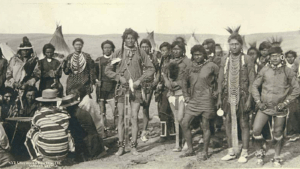“You can be sad and thankful, just like you can be full and still eat pie,” was the oh-so-wise adage shared far and wide across the internet in November. This statement is lighthearted but also points to a deeper truth: life isn’t lived in compartments, with happiness scheduled for the morning and worry scheduled for the afternoon. Rather, we experience a variety of emotions, circumstances, and perspectives all at once.
Question for reflection:
When have you experienced multiple feelings simultaneously? For example, recall a time when you were both excited and apprehensive about something new.
We navigate a multi-faceted reality all of the time. And yet, when this season of the year rolls around (that is, Advent through Christmas), we might find ourselves sliding right into society’s pressure to act as though there is only one reality: perpetual holiday cheer. We’re supposed to be incessantly happy and eternally grateful. We’re preparing for the birth of our Savior, for love Incarnate, after all. How can we possibly be anything but joyful, anything but inspired?
Question for reflection:
What memories, emotions, and stories does this time of year bring up for you? Have you ever felt forced to “put on a smile” in this season?
Read Luke 2:1-20
Hope indeed abounds in this passage. It’s almost palpable. “Do not be afraid, for see, I am bringing you good news of great joy for all the people: to you is born this day in the city of DavidSecond king of Israel, David united the northern and southern kingdoms. More a Savior, who is the MessiahThe Messiah was the one who, it was believed, would come to free the people of Israel from bondage and exile. In Jewish thought the Messiah is the anticipated one who will come, as prophesied by Isaiah. In Christian thought Jesus of Nazareth is identified... More, the Lord,” the angel proclaims. How can anyone who hears this, anyone who reads this, be anything but content, anything but optimistic?
Hope indeed abounds … but it’s not always what we think, and is rarely what we expect. Because although this news proclaimed by the angel is wonderful, is brimming with hope, it also exists alongside great terror, great risk, and great uncertainty.
JesusJesus is the Messiah whose life, death, and resurrection are God's saving act for humanity. More does not come into a whole and healed world. He enters a world in which hope and despair, hope and anxiety, hope and fear exist together.
Read Matthew 1:18—2:23
Question for reflection:
We like to imagine Christmas in the form of a picturesque Sunday-school pageant, when the story is so much more. When you read this account from MatthewA tax collector who became one of Jesus' 12 disciples. More, what is your reaction? Ignore the hard parts? Ask questions? Sit with the discomfort?
Truly embracing and living into the hope that Jesus brings is only possible when we read the full story, with all its messy and harsh details, and when we are honest about the complicated and challenging situations we find ourselves in today.
Hope for this time of year, and always, at least in a biblical sense, is not mere optimism. Hope is not based on wishful thinking or even on believing that everything will work out for the best. Hope, in a biblical sense, is centered in God’s unchanging character and promises. Hope is an anchoring and a relentless pursuit of justice, of new life, of transformation. Hope is expecting—even demanding—God to show up … especially in the birth of our Savior.
Ultimately, optimism, positive thinking, and “good vibes” do not last, do not guide us through the hills and valleys of life. It was not optimism that inspired Mary’s Magnificat or positive thinking that sustained the holyHoly is a term that originally meant set apart for the worship or service of God. While the term may refer to people, objects, time, or places, holiness in Judaism and Christianity primarily denotes the realm of the divine More family when they were refugees in Egypt. It was not “good vibes” that kept Joseph from dismissing Mary.
Hope is far deeper, far grittier, and far more resilient than any of its imposters.
Read Luke 1:46-55
Hope is what allows us to imagine—and then create—a world that is different, a world that lives into the vision Mary so powerfully proclaimed. And we don’t have to set aside our heartache, our pain, or even our doubts, in order to live into this vision that God hopes for creationCreation, in biblical terms, is the universe as we know or perceive it. Genesis says that in the beginning God created the heavens and the earth. In the book of Revelation (which speaks of end times) the author declares that God created all things and... More.
As it turns out, we can be sad and hopeful, enraged and hopeful, tired and hopeful at the same time … just like we can be full and still eat Christmas cookies.
So hope for this December is recalling that the beloved Christmas story, that Jesus’ entry into the world, is no stranger to hardship and uncertainty right alongside profound joy. Hope for this December is knowing that nothing can stop Jesus’ arrival, not even a tyrant on a throne. Hope for this December is daring to imagine God’s kingdom coming, as Mary did.
Hope for this December is not shying away from the realities of Jesus’ time or our own, and allowing the stories of this season to teach and transform us, paying no mind to society’s demand that we put on rose-colored glasses.
Hope is resilient. Hope is gritty. Hope is here to stay. So is our Savior … and so are we.
Questions for reflection:
- How have you understood hope in the past, and how do you understand it today? How would you describe hope in light of the above Scripture passages?
- What does it look like for you to hold onto hope alongside everything else, from joy to pain?
- Why do you think our society is so insistent on always being happy and always being positive? What does it mean to you to go deeper than this, to have hope in a biblical sense?
- How well does your congregation or faith community embrace a biblical sense of hope? How can you help one another do so more fully?





